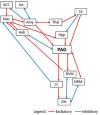Evidence and explanation for the involvement of the nucleus accumbens in pain processing
- PMID: 31638081
- PMCID: PMC6975138
- DOI: 10.4103/1673-5374.266909
Evidence and explanation for the involvement of the nucleus accumbens in pain processing
Abstract
The nucleus accumbens (NAc) is a subcortical brain structure known primarily for its roles in pleasure, reward, and addiction. Despite less focus on the NAc in pain research, it also plays a large role in the mediation of pain and is effective as a source of analgesia. Evidence for this involvement lies in the NAc's cortical connections, functions, pharmacology, and therapeutic targeting. The NAc projects to and receives information from notable pain structures, such as the prefrontal cortex, anterior cingulate cortex, periaqueductal gray, habenula, thalamus, etc. Additionally, the NAc and other pain-modulating structures share functions involving opioid regulation and motivational and emotional processing, which each work beyond simply the rewarding experience of pain offset. Pharmacologically speaking, the NAc responds heavily to painful stimuli, due to its high density of μ opioid receptors and the activation of several different neurotransmitter systems in the NAc, such as opioids, dopamine, calcitonin gene-related peptide, γ-aminobutyric acid, glutamate, and substance P, each of which have been shown to elicit analgesic effects. In both preclinical and clinical models, deep brain stimulation of the NAc has elicited successful analgesia. The multi-functional NAc is important in motivational behavior, and the motivation for avoiding pain is just as important to survival as the motivation for seeking pleasure. It is possible, then, that the NAc must be involved in both pleasure and pain in order to help determine the motivational salience of positive and negative events.
Keywords: analgesia; circuitry; deep brain stimulation; nociception; nucleus accumbens; pain; pain relief; pain signaling; reward; striatum.
Conflict of interest statement
None
Figures


References
-
- Bálint E, Mezey S, Csillag A. Efferent connections of nucleus accumbens subdivisions of the domestic chicken (Gallus domesticus): an anterograde pathway tracing study. J Comp Neurol. 2011;519:2922–2953. - PubMed
-
- Becerra L, Breiter HC, Wise R, Gonzalez RG, Borsook D. Reward circuitry activation by noxious thermal stimuli. Neuron. 2001;32:927–946. - PubMed
-
- Bell D, McDermott B. Calcitonin gene-related peptide in the cardiovascular system: Characterization of receptor populations and their (patho) physiological significance. Pharmacol Rev. 1996;48:253–288. - PubMed
Publication types
LinkOut - more resources
Full Text Sources
Research Materials

